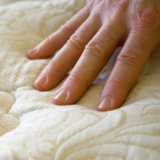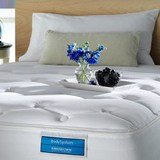Foam Mattress Reviews
Foam mattress reviews can be helpful when it comes to making a decision about which type of foam mattress that would be best for you. Two types of foam mattresses, latex foam and memory foam, are very popular right now for several reasons.
Are they really that different? The short answer is yes, but let's take a look at what the differences are between brands, types of foam, and the processes by which they're manufactured. Let's start with memory foam mattresses.
Memory Foam Mattresses
NASA developed memory foam back in the 1960s, but sometime around the early 1990s someone recognized the opportunity for using memory foam in bed mattresses. It wasn't long after that memory foam mattresses became available to the public for home use
Memory foam, also known as visco-elastic foam, has unique properties that make it an attractive option. The foam is actually a polyurethane product, so when you lie down on it, the foam responds by cradling and moulding to your body. Some memory foam mattress owners have described it as if they are sleeping on a cloud.
The foam provides support and comfort while avoiding pressure on those areas of the body that tend to ache or hurt in the morning after sleeping on a traditional style mattress. The unique cell structure of memory foam allows even air pressure distribution across the surface of the mattress - this is why you feel cradled when you lie down.
Memory foam also responds to temperature. Cold temperatures cause memory foam to become firmer whereas warm temperatures will cause the memory foam to become softer and plusher feeling. Some memory foam products are more successful in regulating body temperature than others.
Mattresses created from this type of foam are not all equal in quality. Unfortunately, a few mattress-manufacturing companies jumped on the memory foam bandwagon by producing inferior quality foam and selling it to unsuspecting customers.
It does cost a bit more for a company to manufacture this type of mattress, so it makes sense that the price of the mattress would be a bit higher for the customer too. Beware of really low-priced memory foam mattresses - they are probably not the quality you want in a mattress. Learn more about this at our memoray foam mattress reviews page.
Foam Mattress Reviews - Latex
Foam Mattresses
Latex foam mattresses are manufactured using latex serum or sap collected from rubber tress. Two different methods are used to create latex foam mattress: the Dunlop method and the Talalay method.
What's the difference between the two methods? Both methods must use a small amount of ammonia in the processing or else the latex serum will coagulate, turning into a useless mass. The ammonia is washed out of the latex foam during later steps in the processing method.
The latex serum is treated the same in both methods in the first few steps of processing. Both methods filter the latex to remove small particulates. Oxygen and water is used next to process the latex and then it's heated and vulcanized. The last stage of processing is where the difference between the two methods is noted.
The Talalay method - right before the latex is heated, it's flash frozen. Then, it's heated once more very quickly. The liquid latex turns into a solid form as a result of this method.
How does that change the feel of the latex mattress? Mattresses produced via the Dunlop method tend to be firmer whereas mattresses made via the Talalay method are softer and feel more luxurious.
Take the time to read latex foam mattress reviews written by latex foam mattress owners - they are the best resource for finding out the truth about brands and types of latex mattresses.
Latex Blends, Organic Latex, & Natural Latex
There are blended latex mattress products out there that utilize both natural latex and synthetic latex. It's always a good idea to ask about what type of latex the mattress was made from and which process was used, Dunlop or Talalay.
Organic latex mattresses can only be stamped organic if there are no sand fillers used in the mattress and if the other materials to complete the mattress are organically derived. Latex itself cannot be organic, but the wool, cotton, or other materials used to finish off the mattress can be organically derived materials.
Natural latex is a mattress resulting in a 90-95% natural product. That means there are a few chemicals used during processing in order to change the liquid latex to a solid form, but otherwise, there were no chemicals used to make the mattress.
Sometimes the price of a latex mattress will indicate whether or not it's truly all natural latex or if it's a blend of synthetic and natural latex. Foam mattress reviews are a great way to find out which brands people have tried and really like.
Essentia - a Latex Version of Memory
Foam Mattress
Essentia is a company that produces the world's only truly natural memory foam mattress. Their design and process is patented, but this much is known about their product. Their rubber sap comes from trees in Indonesia. They've found a way to harvest the sap without killing the rubber tree, which means they are utilizing sustainable practices.
Mattresses by Essentia are built with a bottom layer of Dunlop processed natural latex with a layer of natural memory foam as the next layer. Together, these layers create a sleeping surface like no other in the industry. They cover each mattress with an organic fabric made from unbleached organic cotton.
Essentia Foam Mattress Reviews - Positive Customer
Comments
- The best mattress we have ever slept on
- No odor to the mattress at all
- Excellent customer service - very nice and knowledgeable people, including their delivery associates
- Love that this mattress is made from healthy materials
- No flipping required - great because it's a heavy mattress
- Deep comfort - soft, but supportive
- No more back or neck pain in the morning
- Water based foam - better sleep
- Well worth every penny and the wait to receive my mattress
Essentia Foam Mattress Reviews - Negative
Customer Comments
- Took a long time to receive our mattress - between 2 and 3 weeks, but we think it's because they're a growing company and still trying to figure it all out
- No showroom in some areas of the country - have to buy sight unseen
- Price is more expensive than other foam mattresses
Hopefully, these foam mattress reviews will give you a solid basis for the rest of your research as you shop for just the right foam mattress for you!
Let's All Sleep Better
Help us to spread the word!
Simply copy and paste this code into your Facebook page or blog. Thank you for sharing!



New! Comments
Share your thoughts about what you just read! Leave me a comment in the box below.